Also see: Overview of Oral Fluid Testing
California NORML Guide
Interpreting Drug Test Results
Contents:
Drug Test Detection Times: summary for different drugs and detection technologies.
Detection Time for Marijuana in Urine: Urine tests detect non-psychoactive marijuana metabolites for days to weeks after use, long after impairment has passed.
Detection Time for Marijuana in Blood : Blood tests can detect presence of active THC; high levels indicate recent use, low levels may persist for hours or days.
Marijuana Use and Accident Risks : Accident studies show no relation between urine test results and accident risk; presence of THC in blood a moderate risk factor, comparable to low levels of blood alcohol beneath threshold of DUI; high levels of THC or combination of THC with alcohol indicative of DUI.
Drug Test Detection Times for Marijuana
How long do drug tests detect marijuana? There is no simple answer to this question. Detection time depends strongly on the kind and sensitivity of the test employed; the frequency, dosage, and last time of use; the individual subject’s genetic makeup, the state of one’s metabolism, digestive and excretory systems; and other random, unknown factors.
The basic drug test types and their approximate detection times are shown in the table below.
| Urine | Blood | Hair | Saliva | |
| Marijuana – Single Use | 1-7+ days | 12-24 hrs | Doubtful | Not validated
(0 -24 hours?) |
| Marijuana – Regular Use | 7-100 days | 2-7 days | Months | |
| Amphetamines | 1-3 days | 24 hours | ||
| Cocaine | 1-3 days | 1-3 days | ||
| Heroin, Opiates | 1-4 days | 1-3 days | ||
| PCP | 3-7 days | 1-3 days |
The most popular kind of drug test is the urine test, which can detect marijuana for days or weeks after use. Note that urine tests do not detect the psychoactive component in marijuana, THC (delta-9-tetrahydrocannabinol), and therefore in no way measure impairment; rather, they detect the non-psychoactive marijuana metabolite THC-COOH, which can linger in the body for days and weeks with no impairing effects. Because of THC-COOH’s unusually long elimination time, urine tests are more sensitive to marijuana than other commonly used drugs. According to a survey by Quest Diagnostics, 50% of all drug test positives are for marijuana.
Blood tests are a better detector of recent use, since they measure the active presence of THC in the system. Because they are invasive and difficult to administer, blood tests are used less frequently. They are typically used in investigations of accidents, injuries and DUIs, where they can give a useful indication of whether the subject was actually under the influence.
Hair tests are the most objectionable form of drug testing, since they do not measure current use, but rather non-psychoactive residues that remain in the hair for months afterwards. These residues are absorbed internally and do not appear in the hair until 7-10 days after first use. Afterwards, they cannot be washed out by shampoos (though shampoos may help remove external smoke particles that get stuck in the hair). Hair tests are more likely to detect regular than occasional marijuana use. One study found that 85% of daily users tested positive for marijuana, versus 52% of occasional smokers (1-5 times per week). Ingested cannabis was less likely to be detected than smoked marijuana [01]. It is doubtful whether hair tests are sensitive to one-time use of marijuana.
Saliva testing is a newer, less proven technology. The sensitivity of saliva tests is not well established in the case of marijuana. In theory, they are supposed to detect recent use, but this may range from several hours to over a day. They are supposed to detect secretions from inside the oral tissues that cannot be washed out with mouthwash. Because they are less intrusive than blood or urine tests, the industry has been eager to develop saliva tests. Due to reliability problems, they have yet to gain acceptance in the U.S., but they have come into use in some other countries, such as Australia. An international study of various onsite saliva tests concluded that no device was reliable enough to be recommended for roadside screening of drivers (Rosita Project, 2003-2006).
Urine Testing Detection Times for Marijuana
How long marijuana is detected in the urine depends strongly on frequency of use. In regular users (more than once a week), the marijuana metabolite THC-COOH builds up to a high level, often on the order of hundreds of nanograms per milliliter (ng/ml), from which it may take weeks to decline back below the threshold of detection. The situation is different for occasional users (no more than once a week), who often clear up in a couple of days.
Figure 1 illustrates typical urine testing profiles for “one-time” users – that is, subjects who were clean before going into the test. This would typically be the case for the occasional user who indulges a couple of times per month.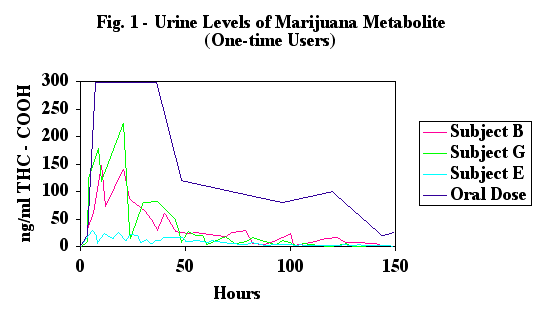
(Data on Subjects B, G, E from Huestis and Oral subject from Law).
Subjects B and G illustrate typical “one-time” responses in a group of study subjects. All subjects received a dose of one standard NIDA cigarette [02]. They were monitored for urine levels of marijuana metabolite (THC-COOH) at regular intervals after smoking. Both B and G were positive at the standard cutoff threshold of 50 ng/ml (the standard in most government-required testing programs) for up to two days after smoking.
Note that urine levels of metabolite fluctuate throughout the day. For example, Subject G fell beneath the 50 ng threshold around 24 hours after smoking, but rebounded above it a short time later. Thus it is possible to flunk a drug test despite having passed one a while earlier.
Subject “E” was an exceptional subject who never exceeded 50 ng/ml despite having smoked the same dose as other study subjects. This illustrates the high degree of individual variation in urine testing. While Subjects G and B would likely have flunked a drug test the day after smoking, Subject E wouldn’t have.
Occasional use can sometimes be detected much longer, as shown in Fig. 1 by the oral dose from a different controlled study [03]. This represents a subject who was given a strong oral dose of 20 mg of THC, equivalent to a strong brownie or two high-dose Marinol pills. The subject tested above the 50 ng/ml cutoff for up to six days after dosing. California NORML has heard unconfirmed reports of occasional users testing positive for as long as two weeks in exceptional cases. In most cases, however, one-time users are likely to pass after a couple of days.
Time to first positive test
Drug metabolites take time to reach the urine. A user who is clean beforehand can test negative for over 1 – 4 hours before turning positive at 50 ng/ml, as shown in the following data from Huestis [02]. This is similar to the period of impairment after smoking. Therefore, in the case of one-time users, a positive urine test is a sign that the user is most likely NOT currently impaired by marijuana!
Figure 2 – Drug Testing Profiles in First Hours Following Single Use
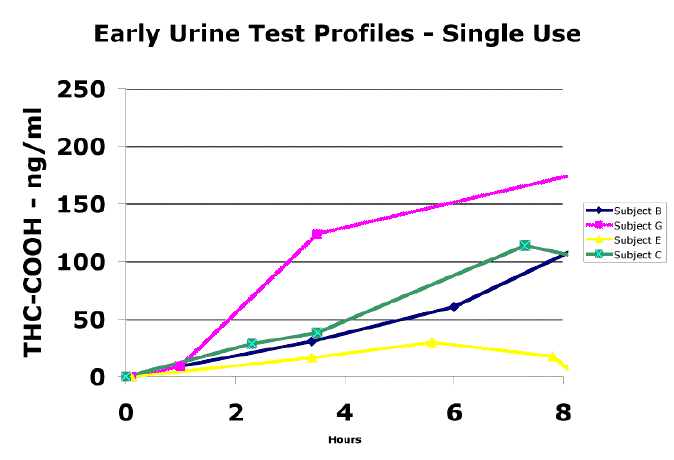
(Early Urine Test Profiles from Huestis et al. [2])
Urine Testing in Regular Users
In regular users, metabolite levels can build up to background levels above 1,000 ng/ml. Many days or weeks of abstinence are required to clear out, as illustrated in the following graph of metabolite levels in test subjects who were regular users [04A].
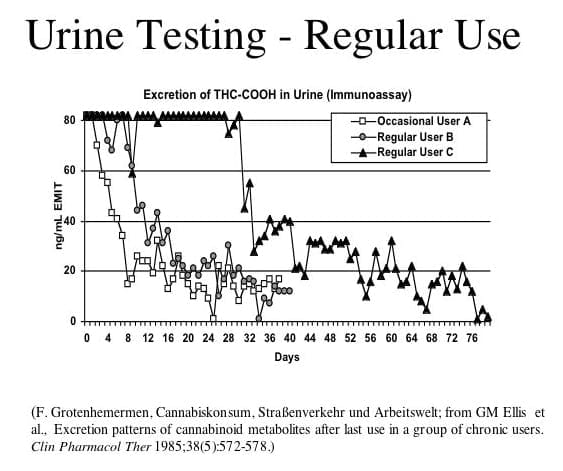 Subject B took over a week to fall beneath the 50 ng/ml cutoff, while Subject C took a month. Detection times over three months have been reported in extreme cases.
Subject B took over a week to fall beneath the 50 ng/ml cutoff, while Subject C took a month. Detection times over three months have been reported in extreme cases.
Note that it is possible to test negative on one day, then positive on the next.
As shown in the following graph, detection times for chronic users typically range from one to three weeks but can extend much longer. In this study by Ellis [04], chronic users were tested at 20 ng/ml and 100 ng/ml, but not at the normal standard of 50 ng/ml.
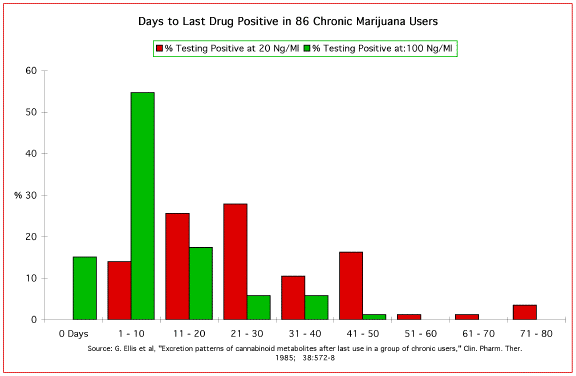
Blood Tests
Unlike urine tests, blood tests detect the active presence of THC in the bloodstream. In the case of smoked marijuana, THC peaks rapidly in the first few minutes after inhaling, often to levels above 100 ng/ml in blood plasma. It then declines quickly to single-digit levels within an hour. High THC levels are therefore a good indication that the subject has smoked marijuana recently. THC can remain at low but detectable levels of 1-2 ng/ml for 8 hours or more without any measurable signs of impairment in one-time users. In chronic users, detectable amounts of blood THC can persist for days. In one study of chronic users, residual THC was detected for 24 to 48 hours or longer at levels of 0.5 – 3.2 ng/ml in whole blood (1.0 – 6.4 ng/ml in serum) [Skopp and Potsch].
Note: THC blood levels can be measured in two ways. Most labs used by U.S. law enforcement report levels based on concentration in whole blood, but others report concentration in blood serum or plasma instead. Concentrations in whole blood are about half as high as those in serum/plasma. Therefore 0.5 – 3.2 ng/ml in whole blood = 1.0 – 6.4 ng/ml in plasma or serum. Unless otherwise stated, whole blood concentrations are reported here.
In another study of 25 frequent users, 36% showed no measurable blood THC throughout 7 days of abstinence, while the rest had at least one positive, though not necessarily on the first day. Six subjects (24%) had detectable blood THC after seven days at levels ranging from 0.2 to 1.5 ng/ml (that is, 0.4 to 3.0 ng/ml in serum) [Karschner]. There have been anecdotal reports of even higher day-after blood THC levels in chronic users, but these haven’t been confirmed in controlled studies.
Unlike urine, blood test results can give a useful indicator of whether one is under the influence of marijuana. Studies have shown that high THC blood levels are correlated with impaired driving. An expert panel review of scientific studies on driving under the influence of cannabis concluded that THC levels above 3.5 – 5 ng/ml in blood (or 7 – 10 ng/ml in serum) indicate likely impairment [Grotenhermen]. The same review found no increased driving hazard at low levels of THC. Despite the fact that accident studies have repeatedly failed to find evidence of increased driving risk at low levels (1 or 2 ng in blood) of THC, numerous states and foreign countries have enacted “zero-tolerance” laws, treating any non-zero trace of THC as legal evidence for driving under the influence. Others have fixed, per se limits above which DUI is presumed, often with no scientific basis. However, most states (including California) don’t have per se limits, but define DUI in terms of whether the totality of evidence (including drug test results) shows that the driver was impaired by marijuana or drugs.
Although high blood THC is a fairly good indicator of being under the influence, it is not infallible. Chronic users who develop tolerance to THC may in some cases drive safely with very high blood levels of THC. In one study, a subject with severe attention deficit disorder could not pass a driving test while straight, but performed well with a blood level of 71 ng/ml [Strohbeck-Kühner]. No similar phenomenon is known for alcohol.
Oral ingestion
Oral ingestion produces a much different THC blood profile than smoking. Instead of peaking sharply, THC rises gradually over a couple of hours to a plateau of around 2.5 – 5 ng/ml in blood (5 – 10 ng/ml in serum), then declines (see blue curve in Figure 5).
Blood metabolites
In addition to THC, blood tests can detect cannabinoid metabolites. Not uncommonly, labs report levels of THC-COOH, the same non-psychoactive metabolite found in urine. As shown in Fig. 5, THC-COOH levels for blood are similar to urine. They may be detectable for a couple of days after a single use or weeks in chronic users, and are therefore not a valid indicator of being under the influence. There is no scientific basis for treating drivers who have THC-COOH but not THC in their blood as being legally “under the influence.”
Another blood metabolite not shown in Figure 5 is 11-hydroxy-THC, a psychoactive byproduct produced when THC is processed by the liver after oral ingestion. While not detectable at appreciable levels in smoked marijuana, 11-hydroxy-THC shows a similar blood profile to THC after oral consumption. The presence of 11-hydroxy-THC may therefore be used as an indicator of recent oral use. However, most blood tests don’t bother to check for 11-hydroxy-THC.
Figure 5 – Blood plasma levels of THC & Metabolite
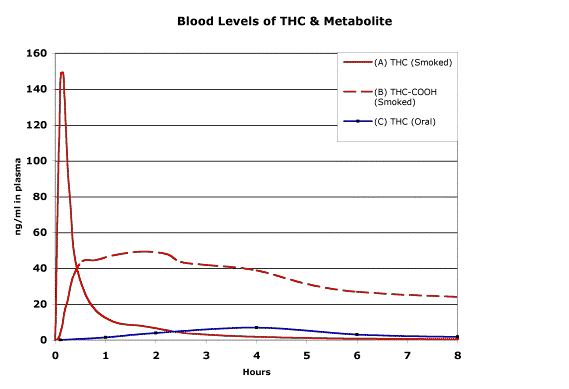
References:
(A-B) Smoked dose based on data from M. Huestis , J. Henningfield and E. Cone,M. Huestis , J. Henningfield and E. Cone.
(C) Oral dose based on data from B. Law et al.
Drug Test Results and Accident Risk
Drug tests are often used indiscriminately as an indicator of driving under the influence of cannabis (DUIC). As we have seen, there is no scientific basis for using urine tests to determine whether one is actually impaired by marijuana, since they only measure the non-psychoactive metabolite THC-COOH. Unfortunately, this has not prevented ignorant lawmakers in certain states from passing “zero-tolerance” laws that define the presence of any cannabis metabolites to be proof of DUIC.
The situation is somewhat more complicated with respect to blood tests for THC, since high levels of THC may be correlated with impairment, though low levels less than 3-5 ng/ml are not. Once again, this has not deterred many lawmakers from passing “zero-tolerance” laws for THC, even though DUI laws typically allow low blood levels of alcohol.
Fortunately, most states (like California) do not have a zero-tolerance DUI standard for drugs, but rather require the prosecutor to show that the driver’s performance is actually drug-impaired in order to get a DUIC conviction. In this event, the driver’s guilt is determined by the totality of evidence in the case: driving behavior, performance on roadside sobriety tests, the driver’s conduct, the smell of smoke in the car – and also drug test results. Defendants can then win acquittal if they can convince the court they were not impaired, regardless of drug test results.
Accident Studies
Numerous accident studies have confirmed that marijuana is not a major risk factor in driving fatalities. A recent meta-analysis of 42 different studies on cannabis and driving concluded that the odds of a fatal accident due to cannabis use are only 1.25 times normal, significantly less than many other risks such as age, gender, and alcohol use [Elvik]. The study found higher fatal accident odds for opiates (1.44), benzodiazepine tranquilizers (2.30), anti-depressants (1.32), cocaine (2.96), amphetamines (4.46) and the sleeping aid zopiclone (2.60). Alcohol wasn’t included, but has elsewhere been calculated at 2 to 6, depending on blood level.
Table 2 summarizes studies that have assessed the accident risk for drivers with traces of marijuana in their system. The studies surveyed fatal accidents, looking at levels of marijuana, alcohol and other drugs in the driver’s blood or urine.
For each accident, researchers determine the degree to which the driver was responsible for the accident. Using this data, they compute a “culpability ratio,” comparing the risk of accidents for drug-positive drivers to drug-free drivers. A culpability ratio of 1 means no increased risk; above 1 mean increased risk; and below 1 means reduced risk. Culpability factors above 3 or 4 are considered notably significant.
As shown in the fourth column of Table 2, drivers with high blood alcohol levels (above the standard legal limits of .08% or .10%) showed consistenly high culpability ratios, on the order of 5 or 6. In contrast, drivers with THC present in their blood rarely exceeded 2, and in several cases were less than 1 – indicating they were actually safer than drug free drivers! This phenomenon has been explained by the fact that marijuana-using drivers tend to slow down, while alcohol-using drivers tend to speed.
One exception is the 2004 study by Drummer et al, which did not count drivers with less than 1 nanogram THC in blood. The remaining THC-using drivers had an average culpability ratio of 2.7, which is similar to the risk ratio for drivers with moderate amounts of alcohol in their system (as shown in the studies by Laumon and Bédard, which looked at drivers with blood alcohol content less than 0.05%, a legal amount in the U.S.).
Note that the Drummer study found especially high culpability for drivers with 5 or more nanograms blood THC, comparable to the risk for drunken drivers. This confirms that high blood THC, indicating recent usage, is a sign of likely impairment, while lower levels, which remain for several hours, are not.
Table 2 does not include culpability data for drivers with both alcohol and THC in their system (that is, all of the marijuana drivers were alcohol-free). In general, studies agree that the combination of alcohol and THC is particularly dangerous, if anything worse than “straight” drunken driving.
Not surprisingly, no elevated risk was found in the three studies listed at bottom, which looked at urine metabolite levels rather than blood THC. This confirms that urine testing has no bearing on driving impairment. Despite this fact, US Department of Transportation regulations force millions of commercial drivers to submit to random urine testing. The government has never produced convincing scientific evidence that this policy is necessary or effective to protect public safety. But they’re the government, so they don’t have to provide any evidence!
Table 2 – DUI Accident Culpability Studies
| Location | # Drivers | Study | Culpability Ratio
Blood alcohol content=.08-.10% |
Culpability Ratio
THC (only) |
| New York | 497 | Terhune & Fell (1982) | 5.7 | 2.1 |
| California | 440 | Williams et al. (1985) | 5.0 | 0.2 |
| U.S. | 1,882 | Terhune et al. (1992) | 5.7 | 0.7 |
| Australia | 1,045 | Drummer (1994) | 5.5 | 0.7 |
| Australia | 2,500 | Longo and Hunter (2000 & 1998) | 6.8 | 0.9 0.36(<1 ng/ml) 1.8 (>2 ng/ml)* |
| Australia | 2,298 | Drummer et al (2004) | 6.0 | 2.7 (>1 ng/ml)
6.6(>5 ng/ml)* |
| France | 10,748 | Laumon (2005) | 3.0 – 6.2 (BAC=.10)
2.01 (BAC=.05) |
1.78 |
| U.S. | 32,543 | Bédard (2007) | 8.51
(3.3 BAC =.05) |
1.29 |
| Studies Looking at Urine Metabolites of Marijuana | ||||
| Netherlands | 110 cases + 816 controls | Movig (2003) | 5.46 (BAC .05–.08)
15.5 BAC >.08 |
1.22 (urine and/or blood) |
| Colorado | 414 | Lowenstein et al (2004) | 3.2 | 1.1 (urine) |
| Maryland | 5,573 | Soderstrom et al (2005) | 7.45 | 1.2 (urine) |
* THC concentration measured in whole blood
Summary: Interpreting Drug Tests in Light of DUID Accident Studies
- THC-COOH metabolite in urine (or blood) NOT correlated to accident risk!
- Presence of THC (only) in blood: LESS OR EQUAL TO RISK of alcohol at .05% (below legal DUI threshold)
- Blood THC = 5 ng: risk COMPARABLE to DUI
- Blood THC = 2 ng = NO increased risk
- THC + alcohol = HIGH DUI risk
- Stimulants (cocaine, amphetamine, etc) = MODERATE risk (~alcohol at .05%)
Footnotes
[01] M Huestis et al., “Cannabinoid concentrations in hair from documented cannabis users,” Forensic Science International (Aug 2006). Available at www.sciencedirect.com.
[02]M Huestis, J Mitchell and E Cone, “Urinary Excretion Profiles of 11-Nor-9-Carboxy-Delta-9-Tetrahydrocannabinol in Humans after Single Smoked Doses of Marijuana,” Journal of Analytical Toxicology, Vol 20:441-52 (Oct 1996).
[03] B. Law et al, “Forensic aspects of the metabolism and excretion of cannabinoids following oral ingestion of cannabis resin,” J. Pharm. Pharmacol. 36: 289-94 (1984).
[04A] Courtesy of F. Grotenhermen, adopted from G Ellis et al, “Excretion patterns of cannbinoid metabolites after last use in a group of chronic users,” Clin. Pharmacol. Ther. 38:572-8 (1985).
[04] G Ellis et al, “Excretion patterns of cannbinoid metabolites after last use in a group of chronic users,” Clin. Pharmacol. Ther. 38:572-8 (1985).
[05] F Grotenhermen et al., “Developing limits for Driving under cannabis, Addiction Vol. 102#12: 1910-7 (December 2007). Also, “Developing Science-Based Per Se Limits for Driving Under the Influence of Cannabis: Findings and Recommendations by an Expert Panel” https://www.canorml.org/healthfacts/DUICreport.2005.pdf.
[06] Strohbeck-Kühner et al, “Fahrtüchtigkeit trotz (wegen) THC” [“Driving ability despite (or because of) THC”], Archiv für Kriminologie 220:11-19 (2007).
[06a] G Skopp and L Potsch, “Cannabinoid concentrations in spot serum samples 24-48 hours after discontinuation of cannabis smoking,” Journal of Analytical Toxicology 32: 160-4 (2008).
[07] EL Karschner et al. “Do Delta(9) THC concentrations indicate recent use in chronic cannabis users?,” Addiction, Oct. 5, 2009 http://www.ncbi.nlm.nih.gov/pubmed/19804462.
[08] M. Huestis , J. Henningfield and E. Cone,“Blood Cannabinoids. I. Absorption of THC and Formation of 11-OH-THC and THCCOOH During and After Smoking Marijuana”,Journal of Analytic Toxicology, Vol. 16: 276-282 (1992).
[09] Elvik, R. , “Risk of road accident associated with use of drugs: A systematic review and meta-analysis of evidence from epidemiological studies,” Accident Analysis and Prevention (July 26, 2012).
Table 2 Accident Studies:
Terhune, K.W. & Fell, J.C. The Role of Alcohol, Marijuana, and Other Drugs in Accidents of Injured Drivers. Technical report for the National Highway Traffic Safety Administration, U.S. Dept of Transportation, NTIS Report No. DOT-HS-806-181. Springfield, VA (1982).
Williams, A.F. et al. Drugs in fatally injured young male drivers. Public Health Reports 100: 19-25 (1985).
Terhune, K.W. et al. The incidence and role of drugs in fatally injured drivers. Washington: US Dept. of Transportation, National Highway Traffic Safety Administration; Report No. DOT-HS-808-065 (1992).
Drummer, O.H. Drugs in drivers killed in Australian road traffic accidents. Victorian Institute of Forensic Pathology, Institute of Forensic Medicine, Monash University, Melbourne, Australia, Report No. 0594 (1994).
Longo, M.C. et al. The prevalence of alcohol, cannabinoids, benzodiazepines and stimulants amongst injured drivers and their role in driver culpability: Part ii: the relationship between drug prevalence and drugculpability. Accid. Anal. Prev. 32, 623–32 (2000).
C. Hunter, R. Lokan, M. Longo, J. White, M. White, The prevalence and role of alcohol, cannabinoids, benzodiazepines and stimulants in non-fatal crashes, Department for Administrative and Information Services, Adelaide, South Australia, 1998.
Drummer, O.H. et al.The involvement of drugs in drivers of motor vehicles killed in Australian road traffic crashes. Accid. Anal. Prev. 36, 239–48 (2004).
Laumon, B. et al. Cannabis intoxication and fatal road crashes in France: population based case-control study. British Medical Journal, 331:1371 doi:10.1136/bmj.38648.617986.1F (Dec 10, 2005).
Bédard, M, Dubois, S, and Weaver, B. The impact of cannabis on driving. Canadian Journal of Public Health, 98#1:6-11. (Jan-Feb 2007).
Movig, KLL et al. Psychoactive substance use and the risk of motor vehicle accidents. Accident Analysis and Prevention 36: 631-6 (2004).
Lowenstein, S and Koziol-McClain, J. Drugs and traffic crash responsibility: a study of injured motorists in Colorado. Journal of Trauma, Injury, Infection, and Critical Care 50#2: 313-20 (2001).
Soderstrom, C et al. Crash Culpability Relative to Age and Sex for Injured Drivers Using Alcohol, Marijuana, or Cocaine. 49th Annual Proceedings, Association for the Advancement of Automotive Medicine, pp.320-41 (Sep 12-14, 2005).
Also see: California NORML’s Drug Testing Tips – Dealing With Urinalysis on Short Notice

